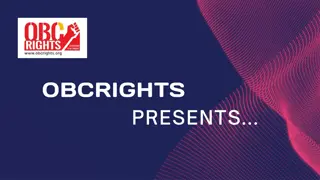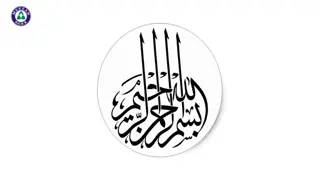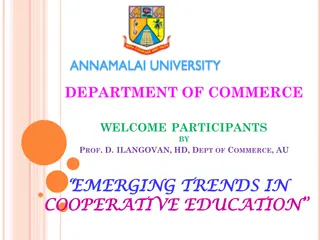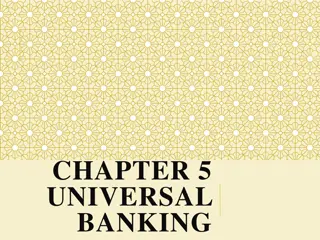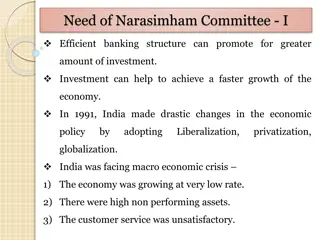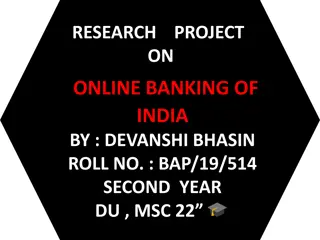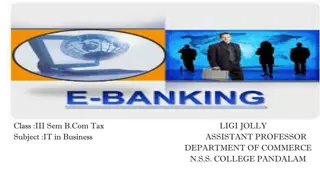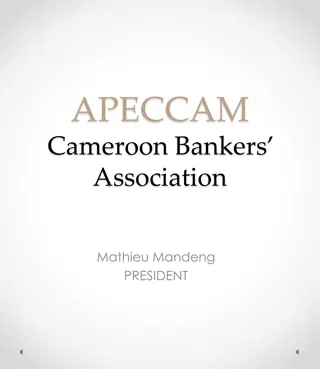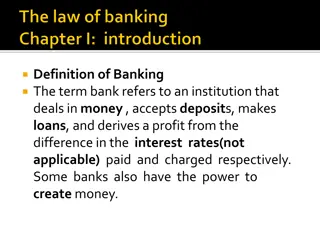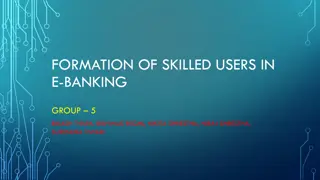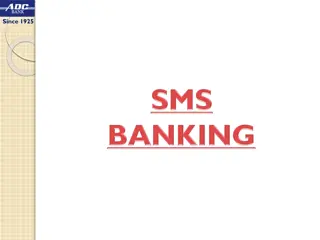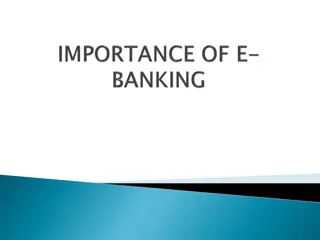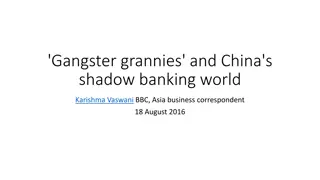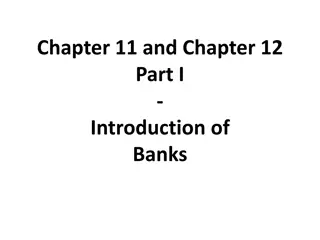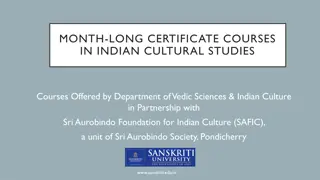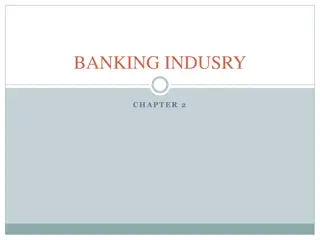Modern Trends in Indian Banking Sector: A Presentation by Prof. D. Ilangovan
The presentation by Prof. D. Ilangovan from Annamalai University's Department of Commerce delves into the evolution of the Indian banking sector. It discusses the historical context, reasons behind innovative trends, and the advent of borderless banking services. The session covers topics such as rapid industrialization, increased international trade, modernization of agriculture, and banking sector reforms. Furthermore, it explores the advancements in technology, including e-banking, online banking, and mobile banking. Prof. D. Ilangovan emphasizes the shift towards value creation, retail banking for rural customers, and mass banking for enhanced productivity. The presentation also provides insights into the total automated teller machines across different categories of banks.
Download Presentation

Please find below an Image/Link to download the presentation.
The content on the website is provided AS IS for your information and personal use only. It may not be sold, licensed, or shared on other websites without obtaining consent from the author. Download presentation by click this link. If you encounter any issues during the download, it is possible that the publisher has removed the file from their server.
E N D
Presentation Transcript
ANNAMALAI UNIVERSITY DEPARTMENT OF COMMERCE WELCOME PARTICIPANTS MODERN TRENDS IN INDIAN BANKING SECTOR BY DR. D. ILANGOVAN, M.COM., PH.D. PROFESSOR, DEPARTMENT OF COMMERCE, ANNAMALAI UNIVERSITY, ANNAMALAINAGAR-608 002 MOB: 09443738926 EMAIL: DIL2691@YAHOO.CO.IN
Prof.D.Ilangovan, HD Commerce, AU 18-04-2020 WELCOME PARTICIPANTS TO THEME PRESENTATION FOLLOWED BY GROUP DISCUSSION 2
Prof.D.Ilangovan, HD Commerce, AU 18-04-2020 INDIAN BANKING IN THE PAST CLASS BANKING LIMITED AND SELECTED SERVICES VERY FEW BRANCHES RARE VOLUNTARY SERVICES LIKE NYC NO INTERNATIONAL CONTACTS AND SERVICES SECTORAL IMBALANCE BETWEEN INDUSTRY AND AGRICULTURE RESTRICTED USE OF CREDIT INSTRUMENTS 3
Prof.D.Ilangovan, HD Commerce, AU 18-04-2020 REASONS BEHIND INNOVATIVE TRENDS RAPID INDUSTRIALISATION INCREASED INTERNATIONAL TRADE MODERNISATION OF AGRICULTURE INTRODUCTION OF NEW ECONOMIC POLICY BANKING SECTOR REFORMS FINANCIAL SECTOR REFORMS GLOBALISATION, LIBERALISATION, PRIVATISATION GROWING ECONOMY 4
Prof.D.Ilangovan, HD Commerce, AU 18-04-2020 BORDERLESS BANKING SERVICES WITHIN THE NATION AND OVERSEAS E-BANKING ONLINE BANKING TELE-BANKING NET BANKING MOBILE BANKING FOR CRM MECHANICAL TRANSACTIONS [THROUGH ATM] PLASTIC CARDS [DEBIT CARDS, CREDIT CARDS and SMART CARDS] 5
Prof.D.Ilangovan, HD Commerce, AU 18-04-2020 BANKING BEYOND BANKING ADVANCED TECHNOLOGY FOR VALUE CREATION RETAIL BANKING FOR RURAL CUSTOMERS BREAK THROUGH IN THE BUSINESS OF LENDING DOWN TO EARTH APPROACH IN DEPOSITS MASS BANKING FOR MORE PRODUCTIVITY 6
Prof.D.Ilangovan, HD Commerce, AU 18-04-2020 TOTAL AUTOMATED TELLER MACHINES Bank Group Bank Group No. No. of Branches of Branches On Site ATM On Site ATM Off Site ATM Off Site ATM Total ATM Total ATM Nationalized Nationalized Banks Banks State Bank of State Bank of India India 33,627 3,205 1,567 4,772 13,661 1,548 3,672 5,220 Old Old Private Private Sector Banks Sector Banks 4,511 800 441 1,241 New New Private Private Sector Banks Sector Banks 1,685 1,883 3,729 5,612 Foreign Foreign Banks Banks 242 248 579 79 7
Prof.D.Ilangovan, HD Commerce, AU 18-04-2020 TOTAL NO. OF ATM VS. TOTAL NO. OF BRANCHES 8
Prof.D.Ilangovan, HD Commerce, AU 18-04-2020 DEBIT CARDS Debit cardsare a mode of convenient payment technique. They allow the spenders to purchase what is in his account only. They don't increase or create loans. These are of two types: Direct Debit Cards: They are used only for on-line transaction of money. They are also called point of sale. It is an immediate transfer of money from customer's account to seller's account. Differed Debit Cards: They bear a visa or Master Card logo. They are used for off-line as well as online transactions. 9
Prof.D.Ilangovan, HD Commerce, AU 18-04-2020 CREDIT CARDS Credit Cardsare a mode of easy payment where the person pays by taking short term loans from banks by using his card. Credit cards charge interest and are primarily used for short-term financing. Most of the stores allow payment of goods and services through credit cards. Because of their wide spread acceptance, credit cards are one of the most popular forms of payment for consumer goods and services in India. The amount of interest charged depends on the bank from which credit card is taken. 10
Prof.D.Ilangovan, HD Commerce, AU 18-04-2020 SMART CARDS They are like credit cards with implanted computer chips in them. The computer chip will store sensitive data and processes them. They are of three types: Memory card Intelligent Card Hybrid Card The smart cards are to be inserted in a smart card reader which encodes it. Then the inbuilt security keys like PIN & 3D passwords are to be given. Its uses have doubled in India after 2004- 05 11
Prof.D.Ilangovan, HD Commerce, AU 18-04-2020 ELECTRONIC FUND TRANSFER EFT helps the banks to provide better customer service. It reduces the work of both customers and banks by reducing the cost of drafts and mail transfer. The electronic credit clearing service helps to credit the dividends directly to the shareholders without using the cheques and other paper works. The major advantages of the EFT are : Printing of the MICR cheques are reduced. Postal delays and other time consuming ways of transferring money are avoided. Loss of the paper instruments like demand draft, bonds, cheques are avoided. Reducing burden of the clearing system. 12
Prof.D.Ilangovan, HD Commerce, AU 18-04-2020 MICRO INK CHARACTER RECOGNITION It is a character recognition system that uses special ink and characters. Negotiable documents like cheques, money orders have special lines of numbers at the bottom which have special magnetic character. To print Magnetic Ink need, you need a laser printer that accepts MICR toner. When number written in this ink is put in the machines, it magnetizes the ink and then translates it. MICR provides a secure, high-speed method of scanning and processing information. 13
Prof.D.Ilangovan, HD Commerce, AU 18-04-2020 COMPARISON OF PAPER BASED TRANSACTIONS AND ELECTRONIC TRANSACTIONS OF INDIA http://upload.wikimedia.org/wikipedia/commons/thumb/c/c0/PAPER_BASED_WORK.jpg/220px-PAPER_BASED_WORK.jpg 14
Prof.D.Ilangovan, HD Commerce, AU 18-04-2020 BIO-METRIC IDENTITY Biometric Identifications Systems consist of a reader or scanning device, software that converts the scanned information into digital form, and, wherever the data is to be analyzed, a database that stores the biometric data for comparison with entered biometric data. Emerging biometrical methods of identification include fingerprints, retinal and iris scans, hand geometry, facial feature recognition, ear shape, body odour, brain fingerprinting, signature dynamics, voice verification, and computer keystroke dynamics Many banks started introducing this identity method in ATMs 15
Prof.D.Ilangovan, HD Commerce, AU 18-04-2020 PRODUCT MANAGEMENT AND PRODUCT MANAGEMENT AND FINANCIAL SERVICES FINANCIAL SERVICES OLD AND NEW OLD AND NEW Confined marketplace Unlimited market space Competition between banks Competition from brands Limited product line Extensive product breadth One-size-fits-all product Customization and innovation Branch-focused e-Enabled, multi-channel players Focus on business growth Focus on revenue growth as well as cost-reduction Revenues through margin Revenue generated through fees and value-added services 16
Prof.D.Ilangovan, HD Commerce, AU 18-04-2020 OUTSOURCING IN INDIAN BANKING OUTSOURCING IN INDIAN BANKING Globally, the banking and financial services sector has been at the forefront of the outsourcing movement. Third party service providers have also built greater processing and analytical capabilities and are able to handle more complex functions like financial modeling and equity research. In contrast with global evolution of outsourcing, the Indian banking industry has been slower to outsource. The Indian banking Industry is highly fragmented. There are banks ranging from small co-operative banks (presence limited to a few branches in a city) to large nationalized commercial banks like SBI with over 10,000 branches (one of the largest banking network in the world). The Indian banking Industry is dominated by PSBs with 70% market share. Further, there are different issues that concern the Indian banks when outsourcing. 17
Prof.D.Ilangovan, HD Commerce, AU 18-04-2020 THANK YOUALL 18






